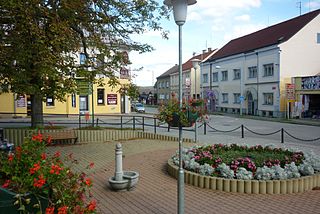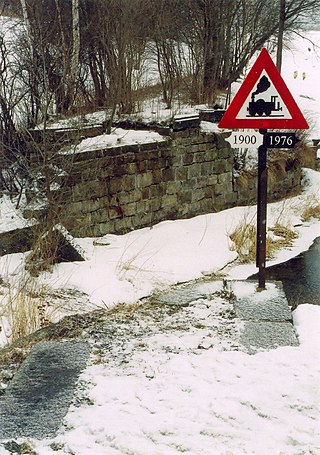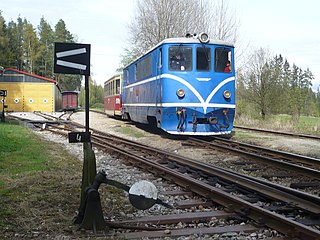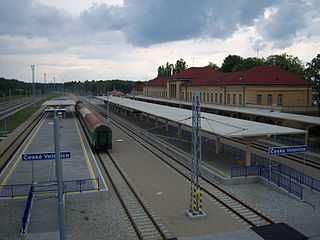
Zittau is the southeasternmost city in the German state of Saxony, and belongs to the district of Görlitz, Germany's easternmost district.

České Velenice is a town in Jindřichův Hradec District in the South Bohemian Region of the Czech Republic. It has about 3,700 inhabitants. It lies on the border with Austria and is adjacent to the town of Gmünd, to which it once belonged.

Frýdlant is a town in Liberec District in the Liberec Region of the Czech Republic. It has about 7,400 inhabitants. The historic town centre is well preserved and is protected by law as an urban monument zone.

In 1864, a committee for construction of a standard gauge railway line connecting Zittau - Reichenau (Bogatynia) - Frýdlant - Liegnitz (Legnica) was established. Negotiations with governments and investors failed.

The narrow-gauge railways in Saxony were once the largest single-operator narrow-gauge railway network in Germany. In Saxony, the network peaked shortly after World War I with over 500 km (311 mi) of tracks. At first, it was primarily created to connect the small towns and villages in Saxony – which had formed a viable industry in the 19th century – to already established standard-gauge railways. But even shortly after 1900, some of the railways would become important for tourism in the area.

The Czech Republic formerly had a large number of narrow-gauge railways. Apart from the public lines listed below, there were many non-public industrial, forest and agricultural narrow-gauge systems; only a few of these are still running.

Bogatynia is a town in Zgorzelec County, Lower Silesian Voivodeship, in south-western Poland. As of December 2021, the town had a population of 16,460.

Gmünd is a town in the northwestern Waldviertel region of Lower Austria and the capital of the Gmünd district. The municipality consists of the Katastralgemeinden Böhmzeil, Breitensee, Eibenstein, Gmünd and Grillenstein. Situated on the Lainsitz (Lužnice) river where it forms the border with České Velenice in the Czech Republic, it is an important road and railway crossing point, next to the Blockheide protected area.
Slovak rail border crossings, as of 2007. Crossings in italic are abandoned. Year of opening in brackets.
Polish rail border crossings as of 2007, abolished cross-border lines are in italic. Year of opening in brackets.

Oybin is a municipality in the Görlitz district, in Saxony, Germany, located very close to the border of the Czech Republic. Following the defeat of the Protestant armies by the Habsburgs in the Battle of the White Mountain in 1620, many Protestant Czechs found refuge across the border in the hills of Upper Lusatia. It is a "Kurort", a resort or spa certified by the state, where people go for rest and recuperation. It is most famous for its mountain of the same name, an exposed natural sandstone dome that towers above the town. The ruins of a medieval monastery lend a wild romantic beauty to it and it was a favorite subject of 19th-century Romantic painters like Caspar David Friedrich. Many bizarrely shaped geological rock formations can be found in the surroundings. The scenic narrow gauge Zittau–Kurort Oybin/Kurort Jonsdorf railway runs from Oybin to Bertsdorf, from there to the neighboring municipality of Jonsdorf and the town of Zittau. Oybin municipality has 3 districts: Oybin, Hain and Lückendorf.

Rail transport in Slovakia began on September 21, 1840, with the opening of the first horse-powered line from Bratislava to Svätý Jur. The first steam-powered line, from Bratislava to Vienna, opened on August 20, 1848.

Rail transport in the Czech Republic carried 193.5 million passengers in 2019, and 68.37 million tonnes of cargo in the year 2009. The majority of passenger services run nowadays are operated by the state company České dráhy, which until 2007 also managed cargo services now run by ČD Cargo. In 2009 the country had 9,420 km of standard gauge track, 3,153 km of which is electrified. There are two main electrification systems in the Czech Republic, 3 kV DC in the northern part, and 25 kV 50 Hz AC in the south. Locomotives had to be changed on boundaries in the past, two-system locomotives have been introduced in 1974. The network has same gauge links to all four countries bordering the Czech Republic with passenger services to all four countries in operation. Major hubs for international passenger services on the network are in Prague, Ostrava, Brno and Břeclav, and the busiest station is Praha hlavní nádraží. The maximum speed for passenger traffic is 160 km/h (100 mph).

Heřmanice is a municipality and village in Liberec District in the Liberec Region of the Czech Republic. It has about 300 inhabitants.

Zittau station is a railway station in Zittau, Germany. The station is located on the Liberec–Zittau, Zittau–Löbau and Zittau–Hagenwerder standard gauge lines as well as it is one terminus of narrow gauge Zittau–Kurort Oybin/Kurort Jonsdorf railway. Until 1945 narrow gauge Zittau–Hermsdorf railway to today's Bogatynia in Poland and Heřmanice in the Czech Republic also began at Zittau station.

The Czech-Polish border is the inter-state border between the Czech Republic and the Republic of Poland. The Czech Republic is one of the seven countries currently bordering Poland. This condition persists since 1 January 1993, when Czechoslovakia collapsed. The current border with the Czech Republic was part of the border with Czechoslovakia and had the same route.
The Franz-Josefs-Bahn is a standard gauge railway line in the Austrian state of Lower Austria. It runs 163.1 kilometres (101.3 mi) from Vienna, the Austrian capital, to the border with the Czech Republic at Gmünd. The line was originally built by the Emperor Franz Joseph Railway and is today owned and operated by Austrian Federal Railways (ÖBB).
Euroregion Neisse-Nisa-Nysa is the first Euroregion created in Central and Eastern Europe, established in 1991. It covers mainly the Liberec Region of the Czech Republic, the state of Saxony in Germany and the Lower Silesian Voivodeship in Poland.

České Velenice is a border train station in the western part of České Velenice in South Bohemian Region of the Czech Republic. It lies on the electrified track České Budějovice–Gmünd (199) and also not-electrified track České Velenice–Veselí nad Lužnicí (226).

Gmünd NÖ is a border train station in the town Gmünd, situated in the Lower Austria. The station is divided to two sections. One is a standard-gauge railway currently operated by Austrian Federal Railways from České Velenice to Wien Franz-Josefs station. The other one is narrow-gauge railway operated by Waldviertler railways between Groß Genungs, Litschau and Heidenreichstein.



















